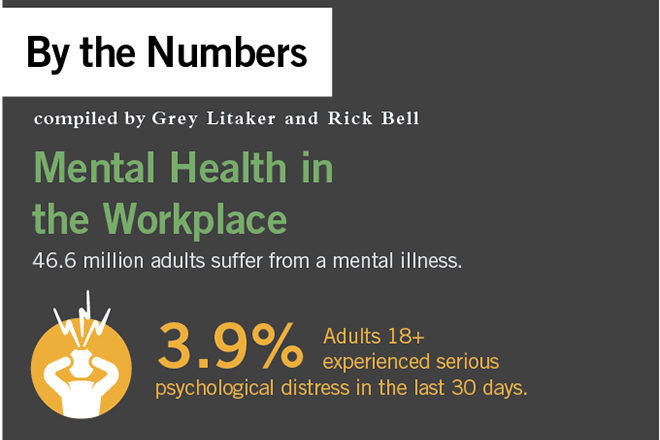My most recent Workforce print feature story is about mental health parity, and that’s one of the topics I love writing about as a benefits reporter: the need for quality, accessible, affordable mental health coverage.
My preliminary research steered me to a new book, “Mind Fixers: Psychiatry’s Troubled Search for the Biology of Mental Illness.” It explores scientists’ ultimately unsuccessful attempts to figure out the cause of mental illness.
The argument is that even though ideas or theories in psychiatry have prevailed in certain moments of history, all of them have been proven inadequate or outright wrong. And we’re still uncertain about both the cause of mental illness and why treatments work on some people but not others.
This sounds cynical, but I love a book that rationally explores the highs and lows of a scientific goal (in this case, to pin down the cause of mental illness). This isn’t discouraging as much as it is proof that people will constantly try to progress their understanding of the world in order to help people with a disorder. It’s more promising to me to see people admit their miscalculations and be determined to move forward than to see people stubbornly hold on to ideas from the past.
There are a few reasons I want to write about this book. The history of mental health treatment and theory is simultaneously fascinating, inspiring and upsetting. Especially in this context, history gives us many examples of how some of the mental health trends we’re now seeing in the workplace may not be exactly new.
I’ve gotten press releases about how people are more depressed or anxious now than ever before — especially millennials (or whatever young generation is being picked apart at the moment). I’ve spoken to people about how prevalent mental illness is and how that has changed over time. I’ve always been skeptical about the idea that it’s more common than in the past. My theory is that it’s more talked about now, more diagnosed now and less stigmatized now, and so the numbers just seem higher. (Feel free to argue against me on this, of course!)
What interested me about “Mind Fixers” was the section about the Cold War Era and how it was seen as the “Age of Anxiety” at the time. Many people relied on the “minor tranquilizer” Miltown, a predecessor of Valium, to deal with that anxiety. Meanwhile, in the 1980s depression became “the common cold of psychiatry.”
Comments like this make me wonder how current trends compared to other periods of history. This isn’t to minimize the impact that mental illness has on people and communities in the present. I bring this up so that we don’t talk about the history of mental health in a way that romanticizes the past. People in the 1950s, the 1800s, and before that had mental disorders, too. The treatments just weren’t as advanced.
According to the National Institute of Health and the Centers for Disease Control & Prevention, 41.2 percent of adults with a mental illness have received mental health services. And, more importantly, this statistic is very gendered if you dissect the data further. While 47.6 percent of women have received this type of health care, only 34.8 percent of men have.
That’s a big gap. Why don’t men get mental health care as much?
There’s a lot written about this already (see the National Alliance on Mental Illness, National Institute of Mental Health and Psychology Today, for example), but here’s a historical angle that shows how deep this goes. “Mind Fixers” briefly explored a 20th century mental disorder known as hysteria.
It was “associated with women and weakness” and men did not receive this label. Fast forward to the 1970s, when people were talking about a new trendy topic called “stress.” It was thought that women were twice as likely to experience stress and depression than men.
This is just a snapshot. Still, it shows how deep these roots are that may tell men that they’re weak if they admit certain things.
Finally, “Mind Fixers” mentioned the unwillingness of insurance companies to cover psychiatric services in 1970s. Lack of benefits coverage of behavioral health is something that even today — after the passage of the Mental Health Parity and Addiction Equity Act in 2008 — is still sometimes an issue.
Also read: Mental Health Parity Law Successes and Challenges
According to “Workforce Attitudes Toward Behavioral Health,” a February 2019 survey from behavioral health company Ginger, 35 percent of the 1,214 U.S. employees surveyed reported that they had to pay directly for behavioral health services their benefits didn’t cover. Further, 85 percent of people said that behavioral health benefits are important when evaluating a job, and 81 percent of people said they face barriers in accessing behavioral health care. The most common barrier (28 percent) was that providers aren’t available in their benefits plan.
I’d strongly recommend this book to anyone interested in the science behind mental health. It brings up a lot of interesting talking points like, How much has stigma improved in the past 200 years, and where is there still room for improvement? Which issues still exist that caused people problems all those years ago as well?
While this isn’t a book about the workplace, you’ll read about certain historical trends and movements that sound a lot like some of the “innovative” solutions you’re hearing about now. Maybe you’ll learn a couple lessons from history.











 A while back a source mentioned to me that many people have a limited view on mental illness. It’s depression; it’s anxiety; or maybe it’s PTSD. But there are many more mental illness conditions to address. Like eating disorders.
A while back a source mentioned to me that many people have a limited view on mental illness. It’s depression; it’s anxiety; or maybe it’s PTSD. But there are many more mental illness conditions to address. Like eating disorders.


 If my
If my  This is all very basic and obvious. However,
This is all very basic and obvious. However,